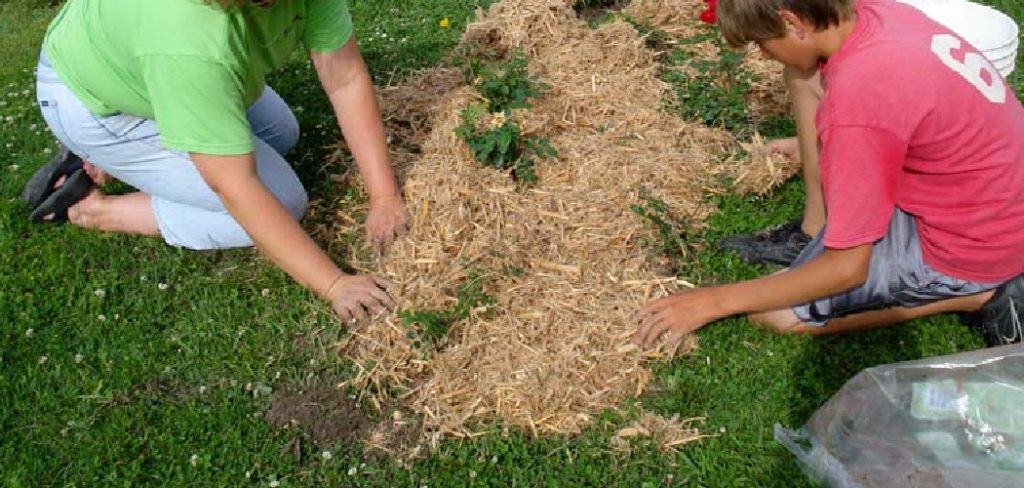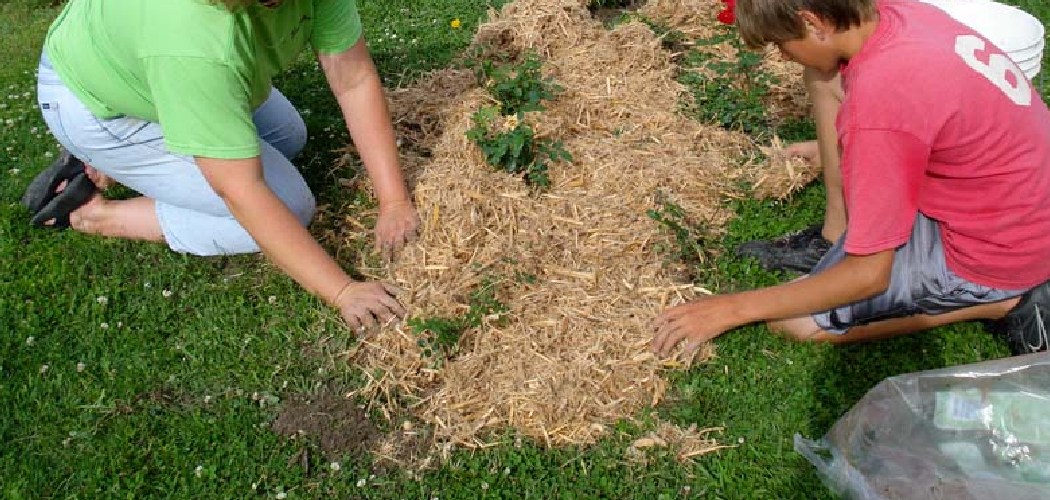To use straw to grow grass, spread it evenly over the area you want to grow the grass in, keeping it moist and providing regular watering until the grass starts to grow. Welcome to the guide on how to use straw to grow grass.
Straw is an excellent natural material that can aid in the growth of grass by providing insulation, moisture retention, and protection from erosion. By following a few simple steps, you can effectively utilize straw to promote the growth of a lush and healthy grassy area.

We will provide you with all the necessary information and tips to successfully use straw in your grass-growing endeavor. So, let’s get started and transform your lawn or garden into a green paradise using this natural and eco-friendly method.
Preparing Your Lawn For Straw Installation
Preparing your lawn for straw installation is an important step in growing grass successfully. Before laying down the straw, it is crucial to clear the lawn of any debris, such as rocks, sticks, and leaves. This ensures a smooth and clean surface for the straw to be placed on.
Additionally, leveling the soil is essential to create a uniform and even base for the straw. Uneven soil can lead to water pooling and uneven growth of the grass. This can be achieved by using a rake or a garden roller to flatten any bumps and fill in any low spots. Taking the time to properly prepare your lawn will increase the chances of the straw effectively protecting and nurturing the grass seeds underneath.
Choosing The Right Straw For Grass Growth
Choosing the right straw for grass growth is essential to ensure healthy and robust growth. Understanding the different types of straw available in the market can help you make an informed decision. Here are the pros and cons of each type:
| Type of Straw | Pros | Cons |
|---|---|---|
| Wheat straw | Biodegradable and nutrient-rich Easy to spread and work with |
May contain weed seeds Can compact and harden if not properly distributed |
| Barley straw | Slow decomposition rate Effective at preventing weed growth |
Can be expensive May require additional watering for decomposition |
| Pine straw | Provides excellent insulation Enhances soil acidity and fertility |
May require frequent replenishment Not suitable for all grass types |
When selecting the ideal straw for your grass, consider factors such as your grass type, climate, and budget. Wheat straw is a popular choice for its affordability and nutrient content. Barley straw is effective against weeds but might require more care. Pine straw is suitable for acid-loving grasses but needs regular maintenance. Assess your specific needs and choose the straw type that aligns best with your requirements to achieve optimal grass growth.
How to Use Straw to Grow Grass : Step by Step Guide
To use straw for growing grass, follow these steps:
- Select a high-quality grass seed suitable for your region and lawn’s requirements.
- Prepare the lawn by removing any debris, weeds, and rocks.
- Rake the soil to create a smooth surface.
- Spread the grass seed evenly across the lawn using a seed spreader.
- Sprinkle a thin layer of straw over the seeded area (about 1/4 to 1/2 inch thick).
- Use a rake to spread the straw uniformly, ensuring all the seeds are covered.
- Avoid using too much straw, as it may prevent proper seed germination.
- Water the seeded area immediately after spreading the straw.
- Keep the soil moist by lightly watering it every day or as needed.
- Avoid overwatering, as it may displace the seed or promote fungal growth.
- Continue watering the area regularly until the grass reaches a height of 2 inches.
- Gradually reduce watering frequency, allowing the grass roots to establish.
- Monitor moisture levels and adjust your watering schedule accordingly.
By following these steps, you can effectively use straw to grow a healthy and vibrant lawn.
Seeding The Lawn
Seeding your lawn with grass is an effective way to achieve a lush, green yard. However, proper preparation and seed coverage are crucial for successful growth.
Preparing The Grass Seeds
Before seeding your lawn, it’s important to prepare the grass seeds properly. Start by raking the soil to remove any debris, rocks, or existing vegetation. This will create a clean surface for the seeds to germinate.
Broadcasting The Seeds
Once the soil is ready, it’s time to distribute the grass seeds evenly across the lawn. You can use a broadcast spreader or simply sprinkle them by hand. Make sure to follow the recommended seeding rate for your specific seed variety.
Ensuring Proper Seed Coverage
After broadcasting the seeds, lightly rake the soil to ensure good seed-to-soil contact. This will help the seeds to germinate and establish strong root systems. Finally, water the newly seeded area gently to keep the soil moist but not saturated.
Spreading Straw Evenly
When using straw to grow grass, it is important to spread it evenly to ensure optimal growth. One important aspect to consider is determining the required thickness of straw. This can vary depending on the soil condition and the type of grass being grown. It is recommended to consult with a landscaping professional to determine the appropriate thickness for your specific situation.
Once the thickness is determined, spreading the straw uniformly is crucial. Ensuring an even distribution will help protect the seeds from wind and rain erosion while also providing a consistent environment for growth. Avoiding excessive application of straw is also important. Too much straw can suffocate the grass seeds and prevent them from receiving the necessary sunlight and water. Striking the right balance is key to promoting healthy grass growth.
Watering The Seeded Area
To ensure successful growth of grass using a straw cover, proper watering techniques are essential. Maintaining adequate moisture levels is crucial for the seeds to germinate and the grass to establish. When watering the newly seeded area, it is important to provide consistent moisture without overwatering.
Preventing overwatering is equally important as excessive water can lead to the growth of weeds and disease. It is advised to water the seeded area using a gentle spray or misting nozzle to avoid dislodging the seeds. Water the area lightly, making sure not to saturate the soil. Follow a regular watering schedule, providing enough moisture to keep the soil damp but not soggy. This will allow the grass seeds to properly take root and grow.
Maintaining Moisture Levels
One of the most important aspects of growing grass using straw is maintaining moisture levels. It is crucial to monitor dry and hot conditions to ensure the grass receives enough water. Supplementing watering as needed is essential for preventing the soil from drying out. If the weather is particularly hot, increasing the frequency of watering is recommended to keep the grass hydrated.
Caring For Your Lawn After Straw Application
To ensure optimal grass growth after applying straw to your lawn, it is essential to monitor its progress and take appropriate care. Regular mowing is important to maintain the health and vitality of the grass. Trimming the grass to a recommended height promotes even growth and prevents weed establishment.
Additionally, fertilization and weed control are crucial to strengthen the grass and suppress unwanted plants. Applying a balanced fertilizer according to the recommended dosage helps provide essential nutrients for healthy growth. Likewise, employing effective weed control methods can minimize weed competition and ensure the grass receives adequate resources. By diligently observing and addressing the growth of your lawn after the straw application, you can maintain a lush and vibrant lawn.
Troubleshooting Common Issues With Straw And Grass
Learn how to troubleshoot common issues with using straw to grow grass, including proper application techniques, preventing weed growth, and ensuring proper water retention for optimal growth.
| Subheading | Description |
|---|---|
| Patchy Grass Growth | One common issue when using straw to grow grass is patchy growth. This can occur due to uneven distribution of straw across the area, improper soil preparation, or insufficient watering. To prevent patchy growth, ensure that the straw is evenly spread, covering the entire area where grass is desired. Prepare the soil properly by removing weeds and compacted dirt, and cultivate it to create a loose and level surface. Water the area adequately, providing enough moisture for germination and root development. |
| Straw Mold and Decay | Mold and decay can occur in straw used for grass growth, especially if it becomes excessively wet or lacks sufficient ventilation. To avoid straw mold and decay, choose high-quality straw that is clean and free from moisture or signs of decomposition. Store it in a dry area and protect it from rain or excessive humidity. If mold does occur, remove the affected straw and replace it with fresh straw. Properly ventilating the area can also help prevent mold growth. |
| Pests and Diseases | Another issue to watch out for when using straw is the presence of pests and diseases. Straw can attract pests like slugs, snails, and rodents, which can damage the growing grass. Diseases such as fungi and bacteria can also infect the straw and spread to the grass. To mitigate these problems, regularly inspect the straw and surrounding area for signs of pests or diseases. Apply appropriate pest control measures if necessary and promptly address any signs of disease by removing or treating the affected areas. |
Frequently Asked Questions For How To Use Straw To Grow Grass
Will Grass Grow Through Straw?
Yes, grass can grow through straw. The straw provides a protective layer that retains moisture and provides shade, creating a favorable environment for grass growth. Additionally, as the straw decomposes, it adds nutrients to the soil, further promoting grass growth.
How Long To Leave Straw On Growing Grass?
Leave straw on growing grass for 7-10 days for optimal results. Longer durations may lead to suffocation of the grass, while shorter periods may not provide enough protection. Remember to monitor moisture levels and remove the straw if it becomes too wet or starts to decompose.
How Much Straw Do You Put Over Grass Seed?
Spread a thin layer of straw over grass seed to protect it from birds, wind, and erosion. Use around 1/4 to 1/2 inch of straw for optimal coverage.
Do You Water Grass Seed After Straw?
Yes, it’s important to water grass seed after laying straw. Watering helps the seed germinate and establish healthy growth.
Conclusion
In a nutshell, using straw to grow grass is a simple and effective method that can yield impressive results. By providing protection and retaining moisture, straw creates an optimal environment for grass seed germination and growth. Additionally, it acts as a natural mulch, preventing weed growth and erosion.
With careful application and regular maintenance, you can enjoy a lush and vibrant lawn in no time. So why wait? Grab some straw and get started on your grass-growing journey today!

